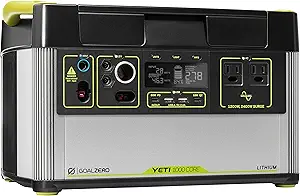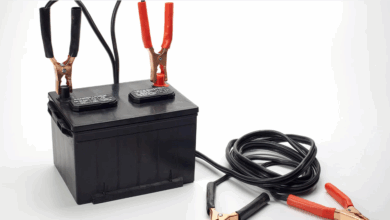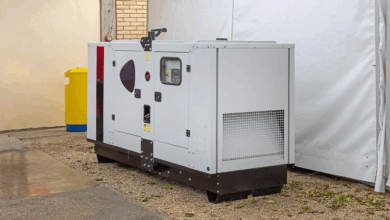Goal Zero Yeti 1000 Core Review – Is It Worth It Compared to the Competition?

Quick Overview: Goal Zero Yeti 1000 Core
- Weight: 31.8 lbs
- Dimensions: 9.86 x 15.25 x 10.23 inches
- Continuous Output: 1200W | Surge Output: 2400W
- Battery Capacity: 983Wh (10.8V, 91Ah)
- Input Capacity: 300W
- Charging Options: Wall, Car, Solar
- Technology: Pure sine wave inverter, MPPT charge controller
- Battery Cycle Life: ~500 cycles
- Ports: 3 USB-A, 2 AC outlets, USB-C, 60W fast charge, and 12V regulated port
My Review After 9 Months of Real Use
After nine months of using the Goal Zero Yeti 1000 Core, I can confidently say this is one of the most dependable 1000-watt portable power stations I’ve owned. I’ve also shared my impressions after 4 months in this earlier review, but this update reflects longer-term usage.
Whether on Overlanding trips, weekend camping adventures, day outings, or during emergency power outages, the Yeti 1000 Core has never let me down.
It delivers 1200W of continuous power with a 2400W surge capacity, which has been plenty for charging my camera gear, drone batteries, GPS devices, and more. The surge power also proves useful when powering small appliances or motor-driven tools outdoors.
While I usually pair it with my Nomad 100 solar panels for eco-friendly charging, I’ve also used vehicle charging through the 12V DC port during long drives. It’s versatile and flexible for all kinds of situations.
What’s the Difference Between Yeti 1000 Core and 1000X?
While the Yeti 1000 Core and 1000X look nearly identical, the key difference lies in the inverter size.
- Yeti 1000X: 1500W inverter
- Yeti 1000 Core: 1200W inverter
Everything else, from battery capacity to overall performance, is largely the same. Both are solid performers, but if you need more wattage, the 1000X might be worth considering.
Design & Build Quality
The Yeti 1000 Core is clearly designed with outdoor use in mind. Its compact size, low center of gravity, and rugged aluminum casing make it a solid companion for travel. It fits snugly in a pickup bed without needing to be strapped down.
Notable features:
- Hidden compartment on top for storing charging cables
- Rubber feet to prevent sliding
- Dual cooling fans behind plastic venting to manage heat
- Built-in handles for easier portability
At just under 32 pounds, it might be slightly heavy for some, but I’ve had no trouble moving it around solo.
Compared to the 1000X, the Core model can only handle 300W of solar input (vs. 600W), which is something to keep in mind if faster solar charging is a priority.
Port Options – What Can You Plug In?
The Yeti 1000 Core is loaded with ports for various devices:
- 2x USB-A ports: 5V, 2.4A, 12W max
- 1x USB-C port: 5–12V, 3.0A, 18W max
- 1x USB-C PD 60W (in/out): 5–20V, 60W max
- 2x AC outlets (pure sine wave): 120V, 10A, 60Hz
- 1x regulated 12V port: 12V, 15A, 180W
- 3x 6mm ports: 6–20V, 3A, 60W max
It’s enough to keep laptops, lights, coolers, tools, and small appliances running smoothly.
Charging Options: 3 Ways to Refill the Battery
1. Solar Charging
The Yeti 1000 Core supports up to 300W of solar input, which might seem limited for a 1200W unit, but in practice, it’s been sufficient.
With my Nomad 100 panels, a full charge takes roughly 4 to 4.3 hours in good sunlight. Keep in mind lithium batteries don’t charge at a consistent rate—charging speeds up from 20% to 80% and slows again near 100%.
2. Wall Charging
This is the slowest method. With a 120W AC wall adapter, it takes nearly 9 hours to go from 0 to 100%. It’s fine overnight but not ideal for quick turnarounds.
3. Car Charging
Car charging pulls 120W from a 12V outlet, taking about 9.2 hours for a full charge. It’s not the fastest, but it works well during road trips when the generator is in use while charging.
What Can You Power with the Goal Zero Yeti 1000 Core?
Here are some estimated runtimes:
- Mini Fridge: 15–18 hours
- Laptop: 17–20 hours
- Camera: 50–55 charges
- Drone: 15–17 charges
- Electric Grill: 14–16 hours
- Cordless Drill: 12–14 charges
It performs very well under realistic usage, even running multiple devices simultaneously without an issue.
Performance Highlights
This unit is powered by a high-efficiency inverter and features a low self-discharge battery, which is noticeable even after long idle periods.
Despite having just two AC outlets, I’ve powered LED lights, fans, drone batteries, and even my ASTRO AI electric cooler with ease. On average, it runs my setup for 4.5 to 5 hours on a full charge.
The LCD display is detailed and easy to read, showing:
- Input/output power
- Battery level
- System alerts and errors
Another strong point is the Battery Management System (BMS), which minimizes power draw when idle—more efficient than some competitors like the Bluetti AC200P.
Load Test Results
After 9 months, I ran another load test using my Fluke 117 wattmeter and achieved 1188W output without triggering any overload. It’s consistent with my earlier 4-month test, where I reached 1192W.
That kind of stability speaks volumes about its long-term performance and reliability.
⚖️ Comparison Table: Yeti 1000 Core vs Yeti 1000X vs Jackery Explorer 1000
| Feature | Goal Zero Yeti 1000 Core | Goal Zero Yeti 1000X | Jackery Explorer 1000 |
| Battery Capacity | 983Wh | 983Wh | 1002Wh |
| Inverter (Continuous / Surge) | 1200W / 2400W | 1500W / 3000W | 1000W / 2000W |
| Solar Input (Max) | 300W | 600W | 200W |
| AC Wall Charging Time | ~9 hours | ~9 hours | ~7 hours |
| Weight | 31.8 lbs | 31.7 lbs | 22 lbs |
| AC Outlets | 2 | 2 | 3 |
| USB Ports | 3 USB-A, 1 USB-C, 1 USB-C PD | 3 USB-A, 1 USB-C, 1 USB-C PD | 2 USB-A, 2 USB-C |
| Regulated 12V Port | Yes | Yes | No |
| MPPT Charge Controller | Yes | Yes | No (uses PWM) |
| App/Wi-Fi Control | No | Yes (via Yeti App) | No |
| Display Screen | Yes (basic LCD) | Yes (advanced LCD + App View) | Yes (basic LCD) |
| Build Material | Aluminum and rugged plastic | Aluminum and rugged plastic | Plastic casing |
| Bluetooth/Wi-Fi | ❌ | ✅ | ❌ |
| Best For | RVs, camping, off-grid use | High-wattage appliance users | Lightweight outdoor setups |
| Price Range | $$ | $$$ | $$ |
- Yeti 1000 Core: Ideal if you want Goal Zero’s durability and efficient inverter at a better price, without the app or high-watt inverter.
- Yeti 1000X: Better for heavy-duty users who want app control and more power output.
- Jackery 1000: Great if you prefer something lighter with more AC ports, but with slightly lower inverter power and less durable casing.
Should You Buy It?
If you’re looking for a durable, well-built, and efficient 1000W solar power station—especially for RVs, trailers, or off-grid adventures—the Goal Zero Yeti 1000 Core is a smart investment.
It may lack Bluetooth/Wi-Fi app control and could benefit from more AC outlets, but what it does offer is rock-solid performance, a compact build, and clean, reliable power.
Pros
✅ Affordable for its class
✅ Excellent inverter efficiency
✅ Low standby power usage
✅ MPPT charge controller included
✅ Great for camping, RVs, and emergencies
✅ Three flexible charging options
✅ Durable and travel-ready design
Cons
❌ No app or wireless control features
❌ Limited number of AC outlets




![How to Bypass CO Sensor on Generator – [4-Step Safety Guide]](https://www.generator411.com/wp-content/uploads/2025/08/co-sensor-on-generator-390x220.png)